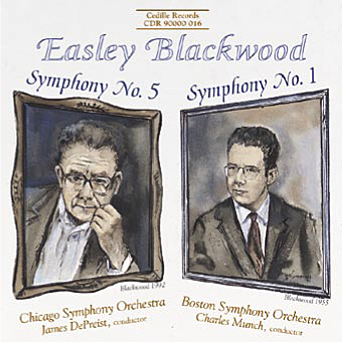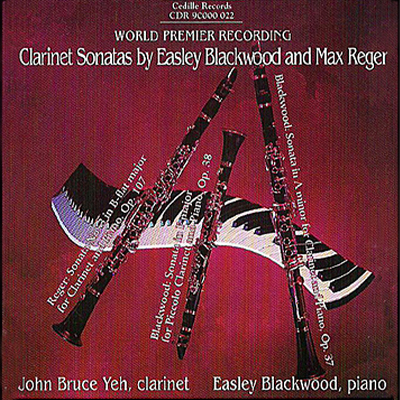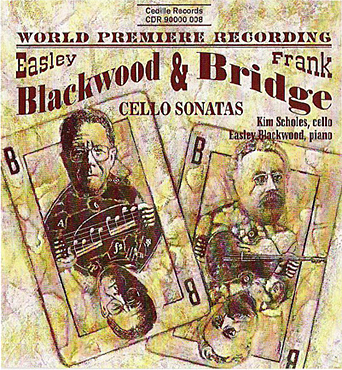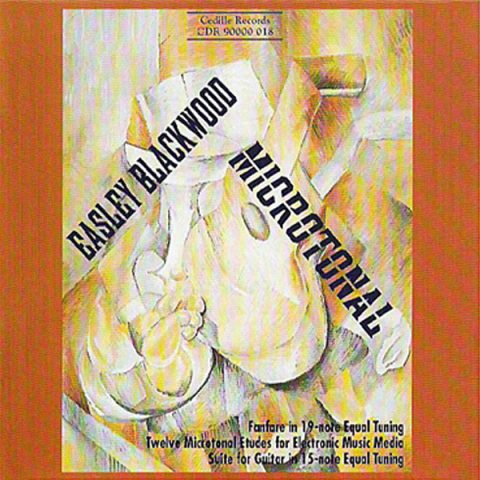| Subtotal | $18.00 |
|---|---|
| Tax | $1.85 |
| Total | $19.85 |
Store
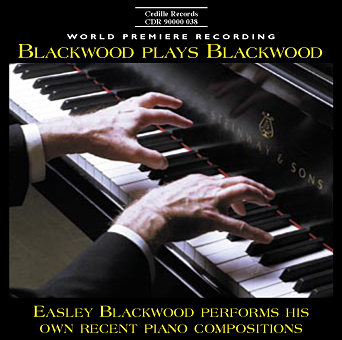
American composer and pianist Easley Blackwood continues to branch out in attractive new directions. On this CD, Blackwood Plays Blackwood, he performs world premiere recordings of his own recent piano compositions. Challenging to perform yet easy to listen to, these new works blend traditional forms with inventive harmonies.
A student of Nadia Boulanger, Olivier Messiaen, and Paul Hindemith (at Yale), Blackwood first garnered worldwide attention for his vigorous, modernist, highly original First Symphony, premiered in 1958 by conductor Charles Munch and the Boston Symphony Orchestra. As a pianist, he is cited in Baker’s Biographical Dictionary Musicians “for his performances of modern works of transcendental difficulty.” During most of his 40 years as a professor at the University of Chicago (1958-1997), he was an exponent of atonality. He came to embrace traditional tonality by way of his landmark study of microtonal music in the 1980s.
On this CD, the Indianapolis native performs five lyrical works for solo piano, completed between 1984 and 1996, including his first large-scale (28 minutes) composition for solo piano, the Sonata in F-sharp minor.
Preview Excerpts
EASLEY BLACKWOOD (b. 1933)
Five Concert Etudes, Op. 30
Seven Bagatelles, Op. 36
Sonata in F-sharp minor, Op. 40
Artists
Program Notes
Download Album BookletSolo Piano Compositions by Easley Blackwood
Notes by Easley Blackwood
Five Concert Etudes, Op. 30
My Five Concert Etudes were written between 1981 and 1984. Their idiom was suggested in part by discoveries associated with my research into microtonal scales. In particular, equal tunings of 16 and 18 notes contain seventh chords that may be arranged into attractive symmetric progressions that have analogous versions in the standard 12-note tuning. These progressions are not unlike what was emerging in the music of the impressionists at the turn of the 20th century. It is surprising that composers at that time did not discover them, although there are occasional hints to be found in Debussy and Scriabin. The first Etude was conceived so as to present the family of progressions in a systematic manner, as was the case with my Twelve Microtonal Etudes (1980) (Cedille CDR 90000 018).
A study of sets of concert etudes by Chopin, Schumann, Liszt, Scriabin, Debussy, Rachmaninov, Stravinsky, and Bartók provided further ideas for completing a set. In general, composers of concert etudes tend to avoid the common problems that all pianists must address via special exercises — scales, arpeggios, trills, and the like. Thus, concert etudes are not intended to develop technique; rather, they confront an advanced player with an array of unusual problems, such as double notes, interior melodies, singular sonorities, or wide leaps, often in unusual keys. The style that emerged from my first Etude seemed more Russian than anything else, and I attempted to maintain a similar idiom with variations throughout the set. With a stretch of imagination, one can liken the first to Scriabin, the second to Tchaikovsky, the third to Mussorgsky, the fourth to Rachmaninov, and the fifth to Prokofiev.
The first Etude is not in any standard form, although the opening phrase is treated as a refrain that is heard four times throughout the piece. It features a rolling five-part texture in the Dorian mode, heard first in G- sharp minor, then in G minor, E-flat minor, and finally in G-sharp minor twice near the close. The principal harmonies are minor-seventh chords and half-diminished sevenths in all inversions, with triads occurring only rarely. An unusual feature: although in G-sharp minor, the Etude contains no F-double-sharps at all.
The second Etude uses triads and seventh chords in more conventional configurations. It is in a two-part Solo Piano Compositions by Easley Blackwood form in which the second half is a transposed variation of the first half. The succession of keys is E major, G- sharp minor, D-sharp minor, B major, B minor, D major, D minor, and B- flat major. At this last modulation, the transposed variation begins; and since the piece has progressed from E to B-flat — halfway around the circle of fifths — the same series of transposed modulations brings back E major after the same number of bars (35). The Etude then closes with a brief coda. The only other work known to me that makes use of a similar scheme is Chopin’s Etude Op. 25, No. 3, in F major, modulating to B major, and then back to F major via the same transposed progression.
The third Etude is cast in a consistent rhythmic mode — long-short, long-short — with the long note sometimes dotted, and sometimes double-dotted. There are occasional instances of triple dots as well. The piece is through-composed, although the beginning is recalled at the very end. As the Etude unfolds, there is a gradual increase in chromatic harmonic complexity, which culminates in a climax. This is followed by a sustained passage over a low doubled pedal point — tonic and dominant — that per sists until the end.
The fourth Etude features a harmonic idiom that makes extensive use of more advanced families of altered chords, often in conjunction with suspensions. The form is a simple, conventional ABA with a brief coda. In order to avoid degenerating into harmonic incoherence, the A sections constantly return to the key of the piece (E-flat minor), without clearly establishing other keys via cadences. The central B section is in C-flat major — a key seldom found in the piano literature — with defined passages in E-flat major, A-flat major, and C major. The frequent use of altered chords, along with a key signature of six or seven flats, brings about many instances of double flats, affording special challenge to a skilled reader.
The fifth Etude returns to a harmonic style that is rather like that of the first, but otherwise in quite a different idiom. The refrain is a fanfare-like figure, generally in the Lydian mode, occurring in A major, D-flat major, G major, G minor (Dorian), F major, and A major (the normal major mode). Other portions of the piece make extensive use of seventh chords, sometimes in chromatic configurations. Throughout the Etude, the textures are elaborate contrapuntal or chordal arrangements in four, five, or six parts.
Two Nocturnes, Op. 41
These pieces were written between December 18 and December 23, 1996, although a four-bar fragment of the first had been jotted down many months earlier. Both Nocturnes depart from the more conventional format, which generally presents a singing line over a simple chordal accompaniment. The first Nocturne is very slow; after a two-bar introduction, a languorous melody is heard four times, with slight variations, over a chordal accompaniment that changes character as the melody repeats. The first harmonization is modal (essentially Mixolydian), the second is atonal — the only truly atonal passage in any of the works on this disc — the third is chromatic with unexpected modulations, and the fourth is an abbreviated recall of the first. The piece closes with a four-bar coda.
The second Nocturne is in a variety of shifting modes and constantly modulating, although always returning to a characteristic cadence in A minor Aeolian. Its form is ABAB, with the B-sections using slightly quicker notes, but at a slower pace.
Seven Bagatelles, Op. 40
The Bagatelles were composed over a ten-year period, the last one having been completed on May 31, 1993. In a literary sense, a “bagatelle” is something of little importance, a mere trifle. Musically, however, Beethoven’s two highly esteemed sets of bagatelles for piano have set a standard that goes considerably beyond what is associated with “;trifle.”; Even so, it is clear that the term suggests a shorter piece that avoids any formal intricacy, such as imitative counterpoint or development based on key structure. More appropriate are song forms, rondos, or through-composed pieces made of simpler material than would be appropriate for a longer movement. My bagatelles are entirely tonal in a traditional sense; but unlike some of my other recent compositions, they do make occasional use of the more advanced chromatic seventh-chord resolutions that are found in works written shortly after 1900 by composers such as Fauré, Reger, and Rachmaninov.
Sonata in F-sharp minor, Op. 40
The Sonata was written between July 1 and August 14, 1996, and is my first effort at a large-scale (28 minutes) composition for solo piano. The work is in F-sharp minor — a key that is seldom found in the piano-sonata literature. In fact, only three examples come immediately to mind — Schumann’s first, Brahms’s second, and Scriabin’s third: pieces that can hardly be called well known. My sonata uses the full range of tonal harmonic vocabulary as it had evolved by 1905, as found in works such as Strauss’s Salome and Schönberg’s Gurrelieder. The Sonata features frequent modulations, often between distantly related keys. At one point or another over the course of the piece, all of the key signatures are used, from six flats through six sharps. There are occasional passages consisting of conventional triads and seventh chords where no tonic can be clearly located; but none of these passages can be called atonal, in the strict sense of the word.
The four movements are in traditional forms. The first movement, a sonata form, presents the first theme in F-sharp minor and the more tranquil second theme in D major, with a later section in D minor. The development is highly agitated, and consists of frequent chromatic modulations. In the recapitulation, the second theme is heard in F-sharp major, with the later section in F-sharp minor.
The Scherzo is in B major, and never modulates beyond closely related keys (G-sharp minor, F-sharp major, and C-sharp minor). The Chorale consists of slow chords over a “;walking bass,”; again confined to closely related keys (E-flat major, F-minor, G-flat major, and E-flat minor). The form is conventional ABA, with repeats omitted in the second statement of the A section.
The third movement is in E minor, and the slow parts consist mainly of melodies, accompanied first by chords, and then by arpeggiated figures that gradually increase in speed. The brief, very quick central section frequently changes meter in a random way from 3/8 to 2/4 to 5/8. The slow section’s return is a harmonic variation on the initial version.
The final movement is also in sonata form, but embodies elements of the rondo as well. In this movement, the harmonic idiom returns to something more akin to that of the first movement. The first theme has a rather military character, while the second consists of broadly flowing lines alternating with more tranquil episodes. The piece concludes with a brief coda that abruptly changes character as the meter changes from 4/4 to 9/8.
— Easley Blackwood
Album Details
Total Time: 64:37
Recorded: December 1991, December 1993, June 1997 at WFMT, Chicago, Illinois
Producers: James Ginsburg & Burke Morton
Engineer: Bill Maylone
Production Assistant: David Dieckmann
Cover photo: Dan Rest
Design: Cheryl A Boncuore
Notes: Easley Blackwood
© 1998 Cedille Records/Cedille Chicago
CDR 90000 038
